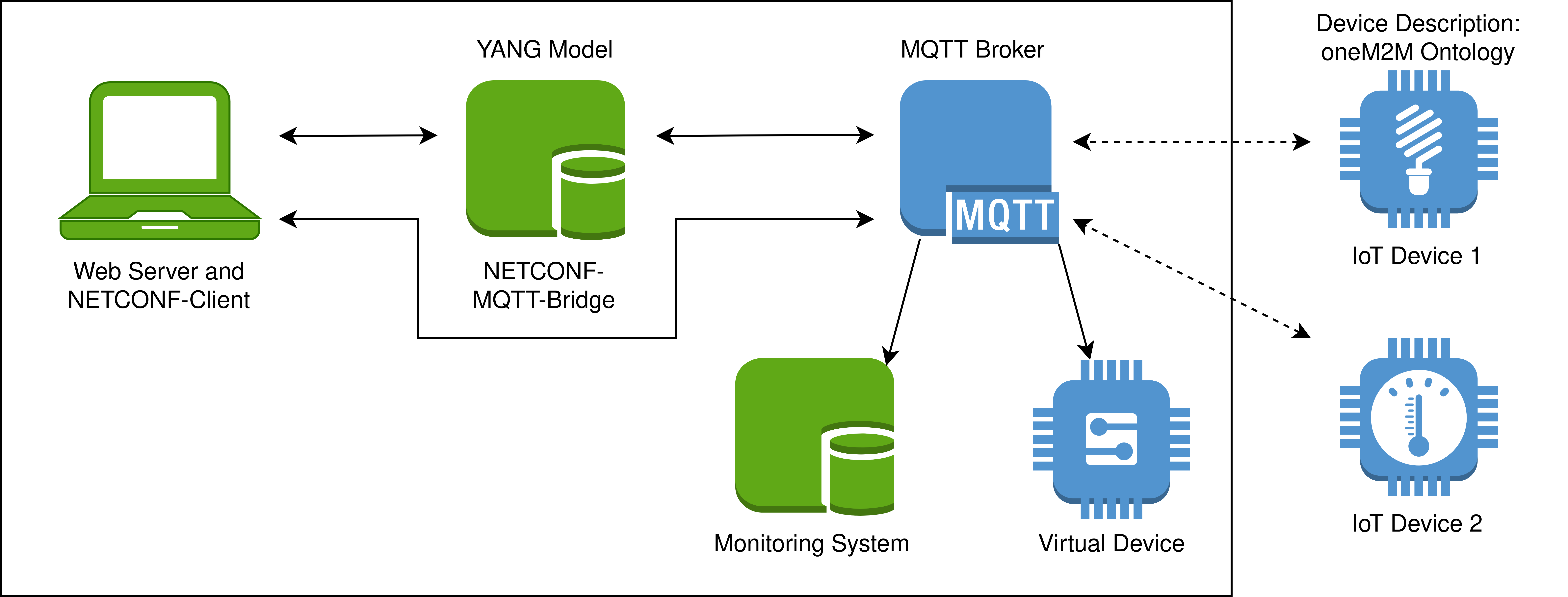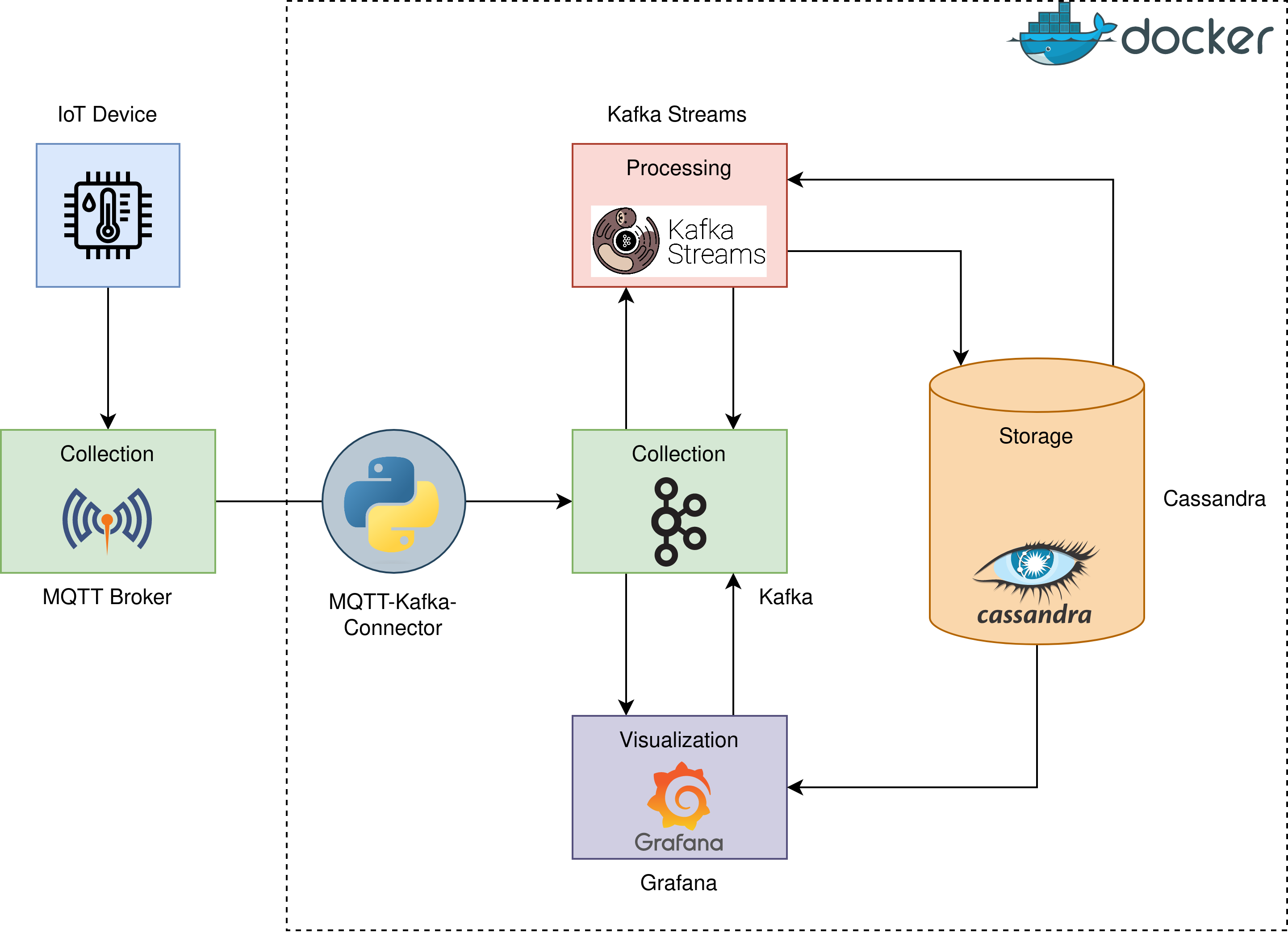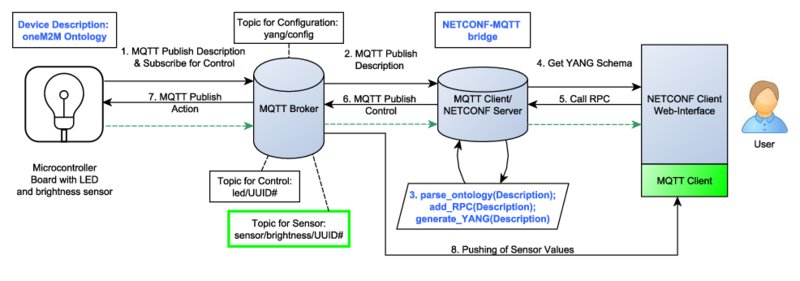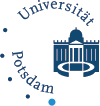Semantic Web in Internet of Things (IoT)
Things in the Internet of Things (IoT) are usually equipped with sensors or an actuator. Sensors enable to measure e.g. temperature, air humidity, light, motion, etc. Furthermore, things can connect to the other things. However, there is no interoperability standard for connecting heterogeneous devices from different vendors in the IoT. Instead, there are several consortia and vendors which work on their own solution, (e.g. Smart Home standards).
One particular challenge in the Internet of Things is the management of many heterogeneous things. The things are typically constrained devices with limited memory, power, network and processing capacity. Configuring every device manually is a tedious task. We propose an interoperable way to configure an IoT network automatically using the existing standards: MQTT, YANG, NETCONF and Ontologies. At the center of MYNO framework a proposed NETCONF-MQTT bridge intermediates between the constrained devices (speaking MQTT) and the network management standard NETCONF. The NETCONF-MQTT bridge dynamically generates YANG data models from the semantic description of the device capabilities based on the oneM2M ontology. A NETCONF-Client-Webserver facilitates a user interface through which the user can inspect sensor data, automate or manipulate actuators and receive event notifications.
Image

Figure 1 depicts the overall MYNO framework. The main components of IoT devices, the NETCONF-MQTT-Bridge and the NETCONF-Client-Webserver are supported by virtual devices and a monitoring system. Virtual devices aggregate data from the actual IoT devices (including statistics) and can be used as an interface to manipulate actuators of different boards simultaneously. With the framework running on different pieces of hardware, MYNO is at its heart a distributed system. In order to check service availability a monitoring system was added. The monitoring system checks for MQTT broker and IoT device availability and sensor thresholds, notifying the user in case of problems. Additionally, the monitoring system also surveils an additional framework: DAAM, the Data Analysis Architecture for MYNO, depicted in Figure 2.
Image

The DAAM framework enables us to collect, process, store and visualize the available data. Data are collected with an MQTT-Client and then processed by Kafka Streams before they are stored along with the original data in a Cassandra database. Grafana is used for visualization and provide the user a method to inspect data.
How MYNO works
Image

Figure 3 illustrates three use cases: a discovery mechanism of IoT devices, an actuator and a sensor scenario. Steps 1.-4. are executed only once upon device discovery. The microcontroller board, as a constrained IoT device, publishes an ontology-based device description to the MQTT broker. NETCONF server receives this message and converts it to the YANG Model which can be interpreted by the NETCONF client. Steps 5.-7. are necessary to control an actuator, e.g. to switch on the led. The RPC call will be translated to a MQTT topic and a message destined for the microcontroller board. Step 8. shows that the client can subscribe to the periodically publishing sensor values.
Related Work
We see our work on semantic interoperability related to the IRTF Thing-to-Thing Research Group and the W3C Web of Things Interest Group.
Current Research
MYNO has been used with different IoT devices. We have previously used hardware from Texas Instruments and Arduino. Currently, we are running a small-scale precision agriculture setup with ESP32 boards. The boards include sensors and actuators. The brightness, soil moisture, temperature and humidity is measured, while a pump is used for automated irrigation based on soil moisture sensor input.
The MYNO framework, i.e. the MQTT-Broker, the NETCONF-MQTT-Bridge and the NETCONF-Client-Webserver are run on a standard Raspberry Pi 3B. The DAAM framework is run on a COTS system, connected by Ethernet to the Raspberry Pi.
We are currently investigating how to detect faulty sensors. We observe that the sensor hardware we use degrades over time. Different to machine-learning based approaches or modelling approaches, we are implementing a sensor fault diagnosis system based on fuzzy logic. Taking sensor specifications and knowledge about our system we were able to derive a simple rule base for detecting different fault types in soil moisture sensors.
For further details please refer our publications.
Dissertation
Kristina Sahlmann
Network Management with Semantic Descriptions for Interoperability on the Internet of Things
[PhD Thesis]
2021
Publications
Sensor Fault Diagnosis for Precision Agriculture
Florian Mikolajczak, Geraldin Montañez Huaman and Bettina Schnor
20th GI/ITG KuVS Fachgespräch: Sensornetze
Potsdam, Germany, September 2023
[BibTex]
[PDF]
Interoperability in the IoT -- An Evaluation of the Semantic-Based Approach
Kristina Sahlmann, Florian Mikolajczak and Bettina Schnor
19th GI/ITG KuVS Fachgespräch: Drahtlose Sensornetze
Berlin, Germany, September 2022
[
BibTex]
[
PDF]
[
Long Version]
MUP: Simplifying Secure Over-The-Air Update with MQTT for Constrained IoT
Devices
Kristina Sahlmann, Vera Clemens, Michael Nowak and Bettina Schnor
Journal Sensors (Open Access)
December 2020
[BibTex]
[PDF]
Ontology-based Virtual IoT Devices for Edge Computing
Kristina Sahlmann and Thomas Schwotzer
8th International Conference on the Internet of Things (IoT)
Santa Barbara, California, USA, October 2018
[BibTex]
[Slides]
Binary Representation of Device Descriptions: CBOR versus RDF HDT
Kristina Sahlmann, Alexander Lindemann and Bettina Schnor
Technical Report, 17th GI/ITG KuVS Fachgespräch: Drahtlose Sensornetze
Braunschweig, Germany, September 2018
[BibTex]
[Slides]
Ontology-driven Device Descriptions for IoT Network Management
Kristina Sahlmann, Thomas Scheffler and Bettina Schnor
3rd Workshop on Interoperability and Open-Source Solutions for the Internet of Things (InterOSS-IoT)
Bilbao, Spain, June 2018
[BibTex]
[IEEE]
[Slides]
Managing IoT device capabilities based on oneM2M ontology descriptions
Kristina Sahlmann, Thomas Scheffler and Bettina Schnor
16th GI/ITG KuVS Fachgespräch: Drahtlose Sensornetze
Hamburg, Germany, September 2017
[BibTex]
The Ad hoc Semantic Internet Protocol (ASIP) for Constrained Devices
Kristina Sahlmann, Thomas Schwotzer and Bettina Schnor
15th GI/ITG KuVS Fachgespräch: Drahtlose Sensornetze
Augsburg, Germany, September 2016
[BibTex]
[PDF]
MOCAP: Towards the Semantic Web of Things
Kristina Sahlmann and Thomas Schwotzer
11th International Conference on Semantic Systems
Aachen, Germany, 2015
Semantische Interoperabilität in Sensornetzen
Kristina Sahlmann and Thomas Schwotzer
Nachhaltige Mobilität, Energiewende und Industrie 4.0, ISBN: 978-3-8305-3575-1
BWV Berliner Wissenschafts-Verlag, 2015
